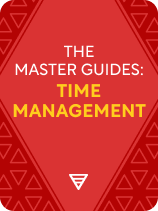

This article is an excerpt from the Shortform book guide to "The Master Guides: Time Management" by Shortform. Shortform has the world's best summaries and analyses of books you should be reading.
Like this article? Sign up for a free trial here.
Do you control your time, or does it control you? What can and should you do with 24 hours every day?
It’s a common refrain—“So much to do and so little time.” Everyone has things they want out of life—goals to achieve, dreams to make real, and the time to enjoy the fruits of our labors. Yet time itself feels like the enemy. It runs out too fast and gets filled with distractions. There has to be a better way.
Continue reading for effective time management strategies from top experts in the field.
Effective Time Management Strategies
Achieving big goals seems too time-consuming, so we set modest goals and keep busy with life’s immediate demands. We work from jam-packed calendars and unprioritized to-do lists that always seem to keep getting longer. Before long, we feel overwhelmed, and even modest goals seem unattainable. All the while, we often think there must be effective time management strategies to get more out of life and our careers while not always feeling that there’s too much to do.
We’ll discuss how to prioritize what you spend time on, how to plan your schedule and keep track of how you use your time, how to avoid distractions and stave off procrastination, and how to balance your life so that you can enjoy your time as you use it more wisely.
Step #1: Set Priorities and Goals
Time management experts generally agree that, instead of trying to do too many things at once, you need to focus on one or two major priorities every day and that these priorities should be in service to a larger goal.
In Eat That Frog!, Brian Tracy frames the importance of having a singular focus in terms of the 80/20 Rule, which states that 20% of the tasks you perform account for 80% of your results. Therefore, if you have five things to do, completing your single most important task will have a greater impact than the other four combined. Each of your tasks may take the same amount of time, but one will generate more value than all the others. Before you start any task, ask whether it’s a top 20% or bottom 80% task, and do it only if it’s in the top 20%.
How do you figure out what your top task is? In The One Thing, Gary Keller writes that you should ask this focusing question: “What’s the one thing I can do that will make everything else easier or unnecessary?” The focusing question takes two forms—a big-picture and a small-focus question: 1) “What’s the one thing I’m working toward?” and 2) “What’s the one thing I should be doing right now?”
The problem is that, in the press of daily life, there are so many potential tasks that it’s hard to weed out the most important ones. In First Things First, Stephen R. Covey provides a helpful diagram to evaluate the tasks on your list based on significance and pressure.
A task can be significant, pressing, both, or neither. In Covey’s method of time management you only do significant tasks, instead of spending time on those that are merely pressing. Tasks that aren’t significant (Zones 3 and 4 in the graph above) add little value to your life, so you should limit the time you spend on those. Also, while activities that are both significant and pressing are inevitable, aim to spend most of your time on tasks that are merely significant (Zone 2). The key is to recognize when seemingly pressing tasks like responding to emails aren’t significant and stop.
One key tool you can use to free your time is delegation. In The 7 Habits of Highly Effective People, Covey writes that, if you have the option, use delegation as a short-term time investment to give you more time for important activities.
Step #2: Make a Plan
A time-management plan isn’t just a to-do list—you need to schedule time to focus on what’s important and organize your time around your true priorities. Brian Tracy says that taking 10 minutes to plan your day can save as much as two hours in wasted time and effort. First, write down everything you have to do. When something comes up, add it to the list. When you work from a list, you can increase your productivity by 25%, so each night you should start your list for the next day, including unfinished tasks from the day before and new tasks to start on tomorrow.
Gary Keller puts a spin on the traditional to-do list by saying you need a “success” list instead. Simple to-do lists are long, disorganized, and can pull you in many directions, whereas a success list is short, prioritized, and aims you in a specific direction. A “success” list includes only those tasks that support your overall objectives, ranked in order of importance.
Protect Your Plan
In Make Time, Jake Knapp and John Zeratzky write that you should block off time on your calendar for your #1 priority, especially if your calendar can be viewed by others at your workplace. You have to be firm with the time you set aside for your priorities, but make sure that you use that time constructively.
Choosing a longer time frame for your plans can help protect your priorities while making room for other tasks. Stephen Covey suggests planning within the framework of a week to balance your big-picture perspective with day-to-day actionables. Covey says to start with the most significant tasks, not the most urgent ones.
Make sure not to schedule every minute of each day so you can maintain flexibility for unexpected problems and opportunities that arise. Covey warns that you’ll inevitably face challenges in your schedule and will need to make decisions in the moment about how to proceed.
Step #3: Track Your Time
It’s also important to track what you’ve done so you can measure how much time you spend on any task, judge how effectively you use your time, and determine what adjustments you should make to your schedule. There are several productivity tools to help you do this.
Bullet Journals
A bullet journal is an organizational tool introduced by Ryder Carroll in The Bullet Journal Method to help you be intentional about how you spend your time and energy. It’s a system that archives your life—past, present, and future—tracking not only the day-to-day details but also your choices, your actions, and how you’ve changed over time.
Carroll explains that, throughout the day, you’ll write down tasks, events, and notes that are relevant to you. To record your information in the most efficient way, he recommends that you use “rapid logging”—a streamlined method of taking notes that focuses on only the most essential information. However, the process doesn’t end there. In bullet journaling, you don’t only record information; you also re-engage with it later.
Through a process Carroll calls migration, you actively assess everything you’ve written and transfer it from one part of your journal to another (or even one journal to another) through daily review, monthly review, and yearly review. Moving information encourages you to reflect on every entry you record, which helps you spend your time and energy with intention.
The Kanban Approach
Kanban is a visual tool first developed by Japanese automakers to keep track of tasks as they move through your workflow. In Personal Kanban, Jim Benson and Tonianne DeMaria explain that, in its most rudimentary version, a kanban is a chart divided into three columns—“to do,” “doing,” and “done.” Unlike to-do lists that simply show tasks until you check them off, a kanban board displays a task’s entire life cycle. The catch is that you’re allowed to have only a handful of tasks in your “doing” column at any one time—perhaps as few as two or three.
A personal kanban board tracks all your tasks, no matter their size, importance, or type. Once you start paying attention to your work patterns, your kanban board will show you at a glance where your bottlenecks are, the tasks you’re struggling with, and how much more work you’re able to take on. Having all of your tasks in one place helps you identify the right task to do now, making sure your energy is going where it will have the most impact. Also, by putting a limit on how many tasks you’re working on at any given time, you ensure that you’re focusing only on priorities you can accomplish.
Step #4: Stay on Target
It takes practice and a conscious act of will to stick to your schedule and avoid distractions, whether they’re external (such as phone notifications) or internal (such as procrastination).
Digital Distractions
The barrage of modern media is so overwhelming that it takes more than sheer strength of will to keep it at bay. In Make Time, tech industry insiders Jake Knapp and John Zeratzky assert that you have to deliberately put barriers in place to keep your devices from stealing your time. The single most pernicious device that impinges on your schedule is your smartphone. Knapp and Zeratsky recommend that you delete all social media apps, games, and even your email from your phone. If that’s too extreme, they suggest you turn off all notifications and remove the apps from your homescreen, forcing you to choose when to use each app.
In the workplace, the other main external distractor is email. Knapp and Zeratsky offer several strategies to take control of your email time, such as only responding to email at the end of the day, or maybe according to an email schedule in which you only check it two or three times per day.
Procrastination
In The Procrastination Cure, Damon Zahariades says procrastination is to delay action on something that’s in your best interest to do now. Most reasons for procrastination are rooted in the fact that your brain prefers immediate rewards to delayed gratification. Put another way, procrastination is a conflict between the interests of Present You and Future You.
Zahariades suggests that the emotional culprit behind most procrastination is fear. Your fear can take many forms, such as fear of failure or fear of success. Zahariades suggests shifting your perspective or using logic to expose your fears as irrational. Reframe failure as a chance to learn, evaluate how realistic your fears are, and consider the outcomes of procrastination, such as feeling overwhelmed later while you’re scrambling to meet deadlines.
In The Now Habit, Neil Fiore recommends that you change your relationship with work and leisure time. First of all, you should change your self-talk. Procrastinators typically talk to themselves in “have to” and “should” statements—both of which build negative feelings that lead to procrastination. Fiore says that you can shift your self-talk to emphasize personal choice—for instance, instead of saying you “have to” or “should” do something, tell yourself you “choose to” or “want to” do that thing.
Making Time Flow
Fiore argues that you can avoid procrastination if you design your schedule so you can enter a state of flow—a feeling of enhanced calm, concentration, and creativity. Fiore suggests that you can enter a flow state by performing focusing and relaxation exercises. The concept of flow, first coined by psychologist Mihaly Csikszentmihalyi, is a frame of mind in which you become so engrossed in what you’re doing that you enter a state of optimal creativity. Managing time is no longer an issue—you may even lose the sense that time is passing.
Step #5: Balance Your Life
The psychological benefits of flow illustrate the most important point to remember when managing your time—you’re not a machine. The ultimate goal of time management isn’t just increased efficiency; it’s finding a way to improve your quality of life.
In Do Nothing, Celeste Headlee’s first piece of advice is to do more focused work so that you can work fewer hours while getting the same amount done. If you have flexibility in your schedule, consider working for about 50 minutes at a time, followed by a 10- to 15-minute break to recharge. Another option is the Pomodoro technique of working in focused 25-minute work sessions, followed by five-minute breaks, with longer 15- to 30-minute breaks after every four focused-work cycles. Whichever strategy you use, Headlee also suggests not working any more than your job requires.
Neil Fiore argues that you should plan your week around your leisure time. Start by writing down specific appointments and necessary activities, then add scheduled leisure time. Fiore recommends at least half an hour of recreation or relaxation per day, as well as dedicating one day per week entirely free of work.
Letting Go of Time
As much as you try to manage your schedule, total control over your time is impossible. In Four Thousand Weeks, Oliver Burkeman argues that, the more tasks you complete, the more tasks will appear to occupy your newly freed-up time. For the sake of your energy and your mental health, prioritize only those tasks that matter most. Don’t take on more than you can handle, and be open to the future veering away from what you’ve planned.
Finally, Burkeman says that, once you accept that you’ll never wield total control over your time, you should align your schedule with the schedules of the people you want to spend time with. The point of time management isn’t to bend time to your will—it’s to let you enjoy the time that you have as much and as often as you can.

———End of Preview———
Like what you just read? Read the rest of the world's best book summary and analysis of Shortform's "The Master Guides: Time Management" at Shortform.
Here's what you'll find in our full The Master Guides: Time Management summary:
- Experts’ advice for prioritizing what you spend your time on
- How to use bullet journals to track your time
- The emotional culprit behind procrastination






